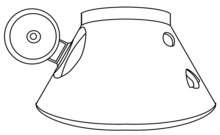



The Vozvraschaemyi Apparat (Russian: Возвращаемый Аппарат, lit. 'Return Vehicle', GRAU index 11F74), or VA spacecraft, was a Soviet crew capsule, intended to serve as a crewed launch and reentry vehicle. Initially designed for the LK-1 human lunar flyby spacecraft for one of the Soviet crewed lunar programs, then the LK-700 redesign, it was later repurposed for the Almaz military space station program.[7][1]
The VA capsule on display at the Smithsonian National Air and Space Museum was labeled as Merkur, following a mistranslation of the original documentation – while incorrect, the name is being used in the West for the VA spacecraft and capsule.[4][5][6]
The VA spacecraft was capable of independent flight – up to 31 hours in its last incarnation – it needed however to be combined with additional hardware (containing propulsion and storage) to achieve a longer flight duration.[1]
Different usage scenarios for the VA spacecraft were planned:
- For the lunar flyby spacecraft LK-1 and LK-700, the plans by Vladimir Chelomei's design bureau OKB-52 were to mate a VA spacecraft together with an Equipment-Rocket System Block (PAB) and Translunar Injection Stage (RB).[7]
- For the Almaz space station program, the plans envisaged two configurations for the crewed VA spacecraft:
- A VA spacecraft would have launched the initial crew of an Almaz-OPS space station, the VA spacecraft launched together with the station itself; This combination was known as "Almaz APOS".[8]
- A VA spacecraft would have been launched mated together with a Functional Cargo Block (FGB) to resupply an Almaz station, in both crewed and uncrewed flights; This combination was known as the TKS spacecraft.[1]
VA was the first spacecraft to be launched into orbit twice, as Kosmos 929 was recovered and launched again as Kosmos 998. Gemini 2 was launched into space twice, but both launches were suborbital.[9]
While the VA spacecraft performed successful uncrewed test flights, both with and without a Functional Cargo Block, it never served in its intended role as a lunar vehicle due to cancellation of the soviet crewed lunar program, and it was never launched together with an Almaz space station.
- ^ a b c d "TKS transport ship 11F72". RussianSpaceWeb.com. Retrieved 30 August 2012.
- ^ "TKS-VA (11F74)". Gunter's Space Page. Retrieved 1 September 2012.
- ^ "TKS". Encyclopedia Astronautica. Archived from the original on 25 August 2012. Retrieved 31 August 2012.
- ^ a b "Space Race". Smithsonian – National Air and Space Museum. Retrieved 1 September 2012.
- ^ a b "Merkur Capsule – Image Detail". Smithsonian – National Air and Space Museum. Archived from the original on 23 April 2013. Retrieved 1 September 2012.
- ^ a b "NASM: Nobody's Perfect". Almaz OPS-5 blog. Retrieved 1 September 2012.
- ^ a b Cite error: The named reference
eaLK1was invoked but never defined (see the help page). - ^ "Almaz APOS". Encyclopedia Astronautica. Archived from the original on 4 October 2012. Retrieved 31 August 2012.
- ^ Cite error: The named reference
collectspacewas invoked but never defined (see the help page).
